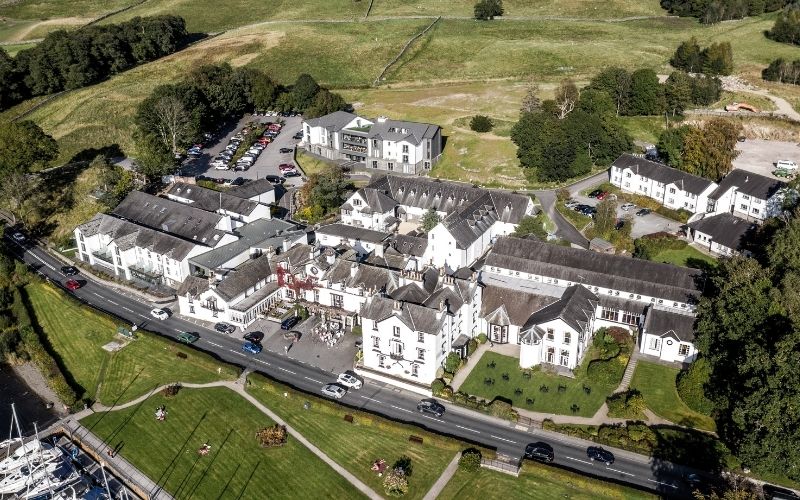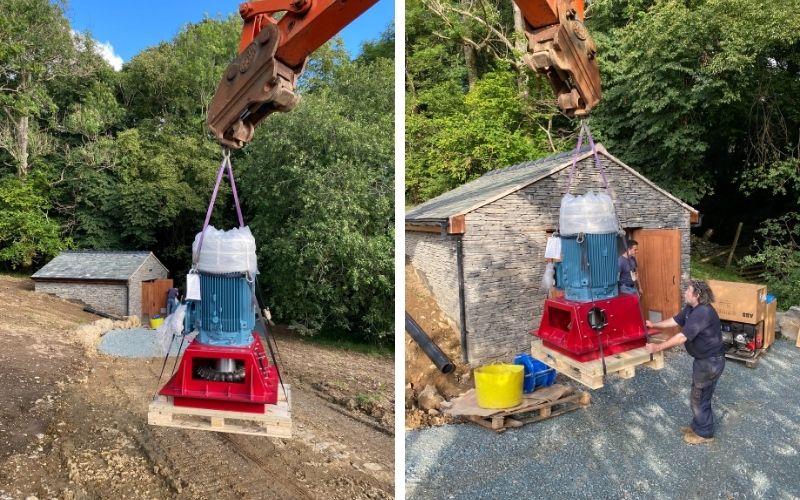Hotels use electricity. Low Wood Bay resort needs rather a lot of it, but now we will be generating our own greener version renewable energy.

Low Wood Bay resort
Without electricity, Low Wood Bay guests would be sitting in the dark with only salad on the menu, or shivering under a grubby unwashed duvet watching a blank TV screen. There would be no lovely Spa facilities to book, no mouth-watering feasts, no party nights or family celebrations, no cosy winter weekend breaks. Perhaps we can do without a trouser press these days, but we will always need heat, light, food and clean linen. The question is not whether we need electricity, but how can we utilise it responsibly.
The team at Low Wood Bay are very aware of the need to reduce our carbon footprint. We consider every aspect of the operation and continually think about how we can be more environmentally friendly, reduce greenhouse gases, and use technology to make us more efficient. These deliberations caused us to work on designing a scheme to generate our own Hydropower electricity, using the free flowing river on the hillside behind the hotel.
History of Hydro Power
It’s certainly not new! Hydropower is one of the oldest methods of generating energy and was used by civilizations over 2000 years ago. There’s evidence of ancient Greeks using the power of water to turn wheels to grind wheat to flour.

Water used to drive waterwheel
By the 1700s modern hydropower plants were developed from this water wheel innovation and by the time of the Industrial Revolution, hydropower energy was used intensively in the UK to spin cotton. Over the past thirty years, large hydroelectric plants in the UK (mostly in Wales and Scotland) have produced 2% of our electricity. Globally, hydropower accounts for around 17% of the world’s electricity production, whilst nuclear energy accounts for around 10%, and other renewable energy sources around 9%. Norway produces a staggering 96% of its electricity from hydropower.
Reducing Our Carbon Footprint
Hydropower harnesses the energy of running water, without reducing its quantity, to produce electricity. This gives it the credentials of being a source of renewable energy.

Renewables produces far less greenhouse gases than gas, coal or oil and is a great choice for reducing our carbon footprint. Across the globe, the use of hydroelectricity over fossil fuels prevents the equivalent emission of greenhouse gases caused by burning of 4.4 million barrels of petroleum per day.
It is true that in recent years there some of the large international hydropower plants have been criticised for harming the environment by causing damage to habitats, impact on fish stock and other livestock, displacement of people and damaging agriculture. Smaller run-of-the-river schemes, like Low Wood Bay, are much more environmentally friendly and have gone through a rigorous environmental checklist to ensure that there is no adverse effects on the environment and to ensure the scenery and wildlife are unharmed.
Low Wood Bay Hydropower
Hydropower schemes utilise the kinetic energy of water flowing downhill. This energy drives a water turbine that creates the electricity. One major advantage of hydro energy over wind or solar power is that the energy production is continuous and is not so dependent on changeable weather conditions. It is also has the ability to respond very quickly to fluctuations in demand – no dash to get home for a hot bath before the rush!

The hydropower system at Low Wood Bay will be taken from a river, Hol Beck, on the private fellside behind the hotel. An 860 metre pipe carries the water at speeds as quick as 79 litres per second, to the turbine below before flowing back into the beck. The vertical fall of the water will be around 90 metres, twice the height of Niagara Falls. The Hydrolite turbine is housed in a dry stone barn type building which blends well into the local Lakeland environment.

The hydropower system is fully automatic, the turbine adjusting the flow through the jets according to the available flow into the tank. This produces the maximum power it can at all times, whilst wasting nothing. We expect the Low Wood hydropower system to generate a power output of 53 kW to 60 kW, generating 180 MWh each year – a third of our total annual requirement.
Glad to be Greener

Tim Berry, Director, English Lakes Hotels by Hol Beck
When we flick the switch on this exciting renewable energy project at Low Wood Bay in September, perhaps nobody else will notice. Heat and light will continue to be generated, our swimming pool will still be warm, and toast will pop up in the morning for breakfast. But, we will have an extra spring in our step and a warm satisfied internal glow knowing that we are doing a little bit more to produce a greener kind of energy, reducing our environmental impact and preserving the natural beauty of the landscape that we call home.
